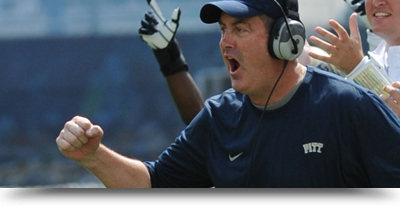Sure, recruiting is a lifeline for any college sports program. No matter how good the coach or the coaching staff, winning regularly without talent and depth is a difficult task. Finding such talent during the recruiting process is essential, and it’s a skill that separates the Urban Meyers and Nick Sabans of the college football world from the Gerry Fousts and Johnny Majors (at least during his second stint at Pitt).
And, over the last 10 to 15 years, recruiting became big business. Guys live in luxurious homes just for following the travails of teenage athletes. Loyal fans pay subscriptions to sites, soaking up information about those who might decide some day to play for their team. Coaches even joined the recruiting hyperbole through social media, as recently witnessed by humorous Twitter posts from various members of the Penn State and Pitt football assistants. (News flash: Of course, Penn State would win this year’s recruiting between the two. Pitt’s had its head coach in place barely a month.)
We’re given national, regional, state and district rankings from every site from ESPN to fan blogs. Players aren’t known as much by name as the number of stars sites like Rivals, Scout or ESPN assigns. Follow those sites and find out when a player is visiting a school and attending a nationally televised basketball game or when that same player narrows 73 scholarship offers to five programs.
Coaches are criticized for not bringing in enough four- or five-star recruits. Recruits are analyzed like they’re entering the NFL Draft.
It’s nauseating, and it’s the most inexact science in sports.
And it all culminates every year with the worst day on the sports calendar – National Signing Day, which happens to be today.
Starting in the morning, fax machines (yes, National Signing Day ensures these devices are still created) light up in college football offices across the country. Twitter, Facebook, Instagram and recruiting websites monitor every National Latter of Intent sent. It’s silly, yet essential. Without good recruits, there’s no chance of winning.
Yet, the analysis is overdone.
Look at Pitt for instance. Two of the Panthers’ best players in 2014 – James Connor and T.J. Clemmings – weren’t sifting through offers from national powers. Yet, Clemmings is a possible first-round pick in the upcoming draft and Connor enters next season as the ACC Player of the Year.
For days leading into Signing Day, we’re told how Antonio Brown – the best receiver in the NFL these days – was an afterthought in the recruiting process. Not many schools wanted offensive lineman Eric Fisher, the No. 1 pick in the 2013 NFL Draft.
Finding players like Brown and Fisher are what separates a decent recruiting class from a good one.
As for those four-and five-star recruits, rankings are often bestowed upon them at camps, when looking good in the uniform matters more than how the player performs in it. There’s an overhyped offensive lineman from Western Pennsylvania who earned a bunch of stars but couldn’t make first- or second-team all-conference as a senior.
So many other factors aren’t weighed on Signing Day.
That five-star recruit may be a head case. He may miss mommy too much. He may have a pregnant girlfriend back home. Worse yet, all three.
Good luck keeping that guy from playing in the PSAC two years from now.
It’s inexact and over-the-top. And it’s affected everything from Division II swimming to Division track.
Because of the attention paid to Division I signings in football and basketball, high schools everywhere are holding “signing ceremonies” – a ridiculous display of lies.
For starters, athletes don’t sign to play for Division III athletics. The reason? There is no athletic scholarship money in Division III. Another common foible in recruiting are the service academies. If someone plays football for the U.S. Naval Academy, that athlete doesn’t sign a National Letter of Intent, he accepts an appointment. As for Division II sports, unless the athlete is playing football, basketball or wrestling, it’s highly unlikely much scholarship money is involved. Yet, high school hold these ridiculous events to appease parents and kids.
Do me a favor, next time you see a “signing ceremony” on your local newscast, look to see if the athlete is actually signing something or just doodling on a blank paper. I’ll take the latter and give you 100:1 odds.





